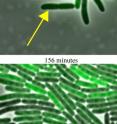Synthetic genetic clock checks the thermometer
Genetic systems run like clockwork, attuned to temperature, time of day and many other factors as they regulate living organisms. Scientists at Rice University and the University of Houston have opened a window onto one aspect of the process that has confounded researchers for decades: the mechanism by which genetic regulators adjust to changing temperature. Until now, synthetic biologists have not been able to duplicate this marvel, but Rice biochemist Matthew Bennett and his team developed a robust synthetic genetic clock that allows Escherichia coli bacteria to accurately keep time in a wide temperature range. The clock, which regulates the production of proteins, does not speed up or slow down with changing temperatures, and offers one possible solution to a problem that has hindered the advance of synthetic biology.
The results were published this week in the Proceedings of the National Academy of Sciences.
The revelation will be of interest to biologists who study regulatory systems, particularly circadian rhythms, but it may be most valuable to synthetic biologists who wish to reprogram cellular regulatory mechanisms for biotechnology, Bennett said.
"One of the problems we've had is that the genetic circuits we build are fragile," he said. "We can build systems that do what we want, but they often do not work well in other people's hands, or if we change the media or temperature. We wanted to create a system that should work independently of the parameters that might be hard for a synthetic biologist to control. We want to show we can build robust circuits, not just by making the architecture of the system more complicated, but by using the right proteins."
The ability to regulate for temperature comes naturally in mammals, but not all life is warm-blooded, and temperature generally affects biochemistry.
"The warmer things are, the more biochemistry speeds up," Bennett said. "This manifests in a lot of ways: Enzymes work faster and biochemical rates are faster."
He said that E. coli, for instance, shows dramatic changes in behavior even within its comfort zone of about 30 to 41 degrees Celsius (86 to 105 degrees Fahrenheit).
"For every 10 degrees Celsius increase in temperature, there's about a doubling in the cell cycle speed," Bennett said.
Among biological processes, there's a notable exception: circadian clocks that keep a steady beat despite the temperature. "We have genetically controlled clocks that help us determine the time of day and coordinate our response to the day-night cycle, changing hormone levels and our alertness. And we're not the only organisms that have them," he said.
"Plants and fungi and even some bacteria that do not have internal temperature regulation also have circadian clocks. For those organisms, it's very important that the period of their circadian clocks remains the same regardless of temperature changes. Your crops, no matter whether it's hot or cold, always keep to the same day-night cycle."
But circadian clocks are also biochemical. "As it gets colder, circadian clocks should slow down, and as it gets warmer, speed up, but they do not," he said. "It's been a mystery as to why that doesn't happen."
Bennett suspected the clocks take their cues from a combination of cellular feedback loops and temperature-sensitive proteins. "Instead of looking at circadian clocks in humans or plants, however, we decided to build a system from the ground up," he said.
His research group started with a synthetic gene oscillator that was built to run in E. coli. Then, by altering a single amino acid of a key protein -- LacI, the lactose repressor -- the researchers made that protein temperature-sensitive and provided the synthetic clock a guide to compensate for changing conditions.
Bennett noted in the paper that engineers have struggled with temperature compensation for a long time, perhaps most famously in the search for a device to give sailors at sea their longitude.
"Temperature compensation is a problem with timekeeping in general," said the researcher, whose first paper as an undergraduate also touched upon the longitude problem. "Metals expand and contract in response to temperature changes, thus altering the period of mechanical clocks.
"This was a major obstacle for early naval chronometers. The man who invented those chronometers, John Harrison, had to compensate for temperature effects. It was a big problem in engineering back then, and we're still finding it to be a problem when we build gene circuits in bacteria today.
Source: Rice University
Other sources
- Synthetic genetic clock checks thermometerfrom Science DailyTue, 7 Jan 2014, 19:30:21 UTC
- Synthetic genetic clock checks the thermometerfrom PhysorgTue, 7 Jan 2014, 18:00:47 UTC

